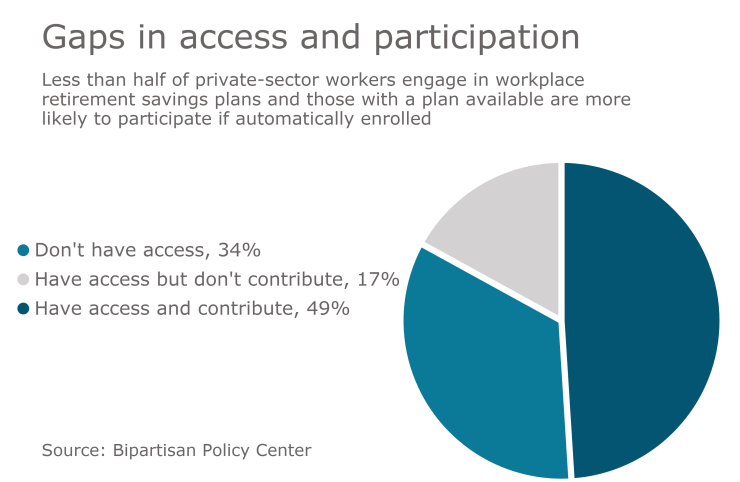There are several retirement-related legislative proposals up for debate right now. While the outcome of those proposals isn’t known, it’s clear that those in the benefit industry can expect certain trends within the defined contribution retirement plan space to continue throughout the year. What we do know is that plan sponsors are focused increasingly on plan design and how it affects participant decisions and financial outcomes.
According to the latest data from the Investment Company Institute, retirement assets in the United States topped $29 trillion as of the third quarter of 2018. Defined contribution plans, such as 401(k)s and 403(b)s, totaled just over $8 trillion. For 2019, the Internal Revenue Service increased the contribution limit for employees in these plans from $18,500 to $19,000.
Expect retirement assets to continue to rise — and look for employers to take more strategic steps to evolving plan designs in the following ways.
Maximizing automatic services. Features such as auto-enrollment and auto-escalation encourage more participants to save at higher contribution rates. In 2019, we’ll continue to see plan sponsors focused on auto-enrollment as a way to boost plan participation and average savings rates. In

In addition, the average employee pretax deferral rate reached 8.3% in 2017. That was the highest we’d seen in 10 years of reporting participant data. Meanwhile, the number of retirement plans with a 6% default deferral rate surpassed the number of plans with a 3% default rate for the first time. Both market appreciation and the increase in default deferral rates helped significantly boost participant account balances as well: on average, accounts saw a $9,583 increase in 2017 compared to a $2,502 increase in 2016.
It’s clear that automated solutions can help overcome participant inertia and have a positive impact on participants' savings behavior. Plan sponsors can take auto-services to the next level by providing these automatic features as an opt-out service. And the next evolution sees plan sponsors tailoring the auto-services available within a retirement plan based on the particular needs of specific segments in the participant population.
Leveraging data and analytics to better understand workforce populations. To drive better usage of benefits, there’s an increased emphasis in this area. Employers can use these insights to encourage participant behavior that generates better financial outcomes, such as higher savings rates, or discourage potentially negative behavior, such as taking 401(k) loans.
Over the past 30 years, we’ve seen the evolution of plan design and communication make headway on increasing retirement readiness. Understanding a company’s culture, participant demographics, and unique communication needs inform a communications strategy that is specifically designed to meet those needs — but thoughtful plan design can only go so far in contributing to retirement readiness. Plan sponsors and recordkeepers should design the digital experience for participants in a way that fosters engagement, from necessary transactional capabilities to educational content, tools, and calculators.
Participants need to be committed to their savings goals and take action to meet them. Interactive and intuitive experiences tailored to an individual participant’s situation can inspire action during brief moments of engagement, such as when a participant logs in to check an account balance. When participants are engaged, they will feel an emotional commitment to their financial futures and be encouraged to take steps toward that future.
Further, analytics that show which experiences resonate the most with plan participants can demonstrate the connection between specific actions. These types of metrics can inform plan sponsor decision-making and spur further plan enhancements to encourage retirement preparedness.
An understanding of what motivates behavior at a particular moment can contribute to increasingly individualized participant experiences, with customized messaging that inspires action and leads to positive outcomes. By personalizing the experience, participants will feel more engaged—and be more encouraged to take action in pursuit of their retirement goals.
Exploring new options for financial wellness and retired participants. We’ve seen an increased emphasis among our clients in the areas of advice and related advisory capabilities. For financial wellness, more and more plan sponsors recognize the value in helping participants with goals beyond saving in a retirement plan.
According to a study of current workers recently conducted by T. Rowe Price, 64% of respondents rely on their 401(k) provider “a great deal” or “somewhat” for financial advice, including advice for financial decisions not related to retirement. Plan sponsors want to provide financial wellness offerings to their plan participants — and they want to be able to measure the return on investment for those programs. This ranges from the appropriate benchmarks and metrics to the suitable timeline to evaluate the impact of the programs on the workforce.
There’s also an increased interest in providing solutions for those in retirement and seeking retirement income. Some plan sponsors have expressed a need for including decumulation strategies in their retirement plans, such as managed payout funds. Many are focused on engaging both pre-retirees and early retirees to help them meet their emerging financial objectives in areas such as longevity protection or drawdown strategies. For example, plan sponsors have been looking for ways to make their plans friendlier to retirees who stay enrolled, such as allowing partial withdrawals.
As we look to 2019 and beyond, retirement plans will continue to evolve their designs to best serve the dynamic needs of their participants. We’re seeing the significant impact plan design and financial wellness programs have on plan participant behavior, including increases in both participation and deferral rates. These trends will lead the enhancements that plan sponsors implement in their retirement plans, encouraging positive behaviors to help individuals reach their financial goals.





